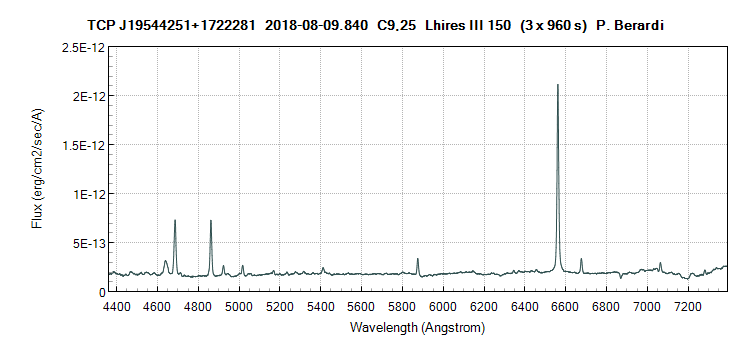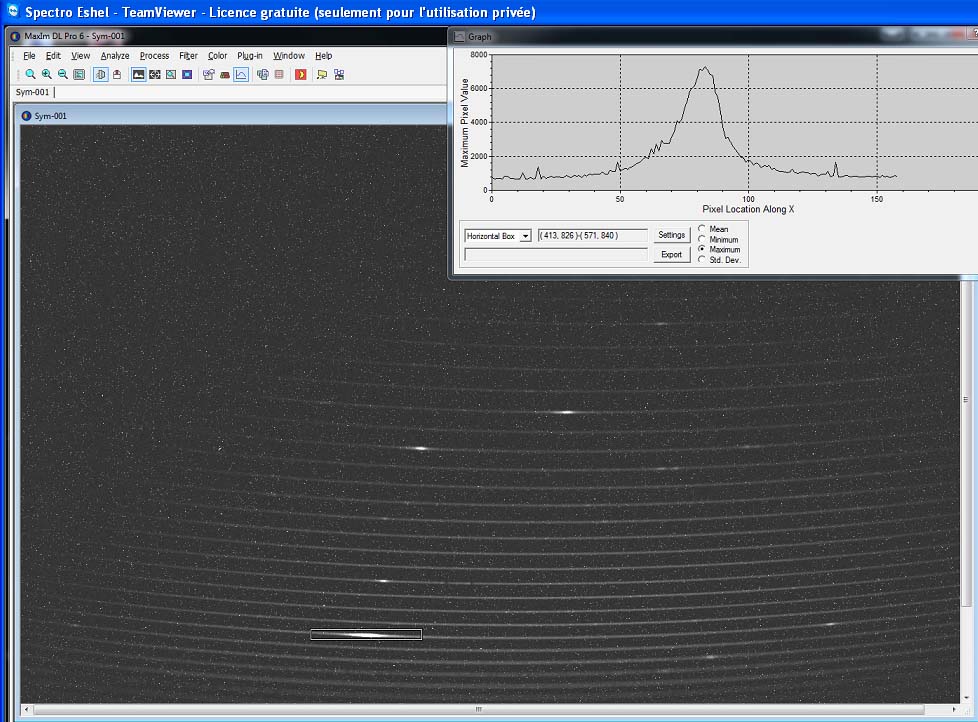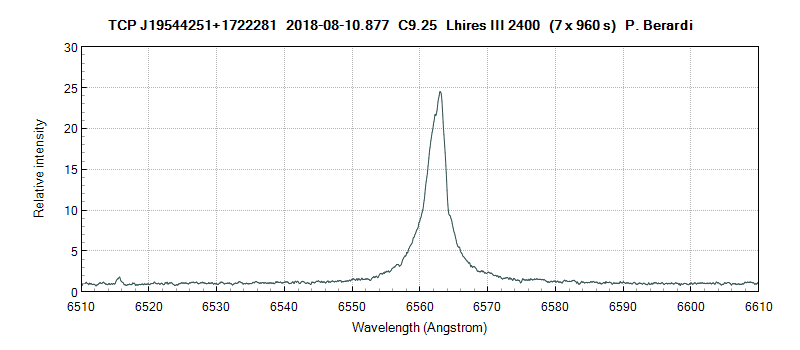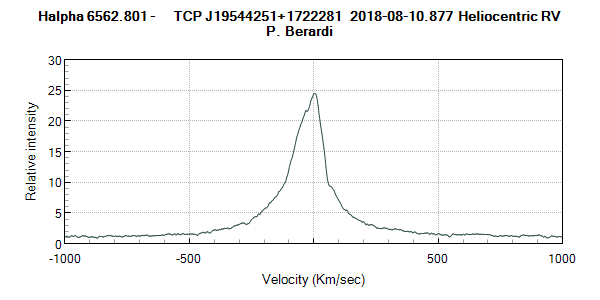ASASSN-V J195442.95+172212.6 10.7V mag in Sge
-
Peter Somogyi
- Posts: 420
- Joined: Sun Jul 13, 2014 8:56 am
ASASSN-V J195442.95+172212.6 10.7V mag in Sge
If the speculation correct, confirmation and spectroscopy should be urgent:
http://www.cbat.eps.harvard.edu/unconf/ ... 22281.html
- Peter
http://www.cbat.eps.harvard.edu/unconf/ ... 22281.html
- Peter
-
Paolo Berardi
- Posts: 578
- Joined: Thu Sep 29, 2011 10:51 pm
Re: ASASSN-V J195442.95+172212.6 10.7V mag in Sge
Hi Peter, the fresh spectrum from Italy (luckily clear sky here). Flux calibrated with mean V mag (10.73) during the observation.

Hydrogen and helium emission lines.
Paolo

Hydrogen and helium emission lines.
Paolo
-
Peter Somogyi
- Posts: 420
- Joined: Sun Jul 13, 2014 8:56 am
Re: ASASSN-V J195442.95+172212.6 10.7V mag in Sge
Thank you Paolo for the spectrum! (especially because I cannot shoot this night...)
Looks like a kind of symbiotic outburst.
Robert Fidrich has this newly found variable star ("Vend S955") already on his observing plan for a longer time, here is his light curve: A fresh Vmag is 10.85V (observer: Tamas Tordai) so it may have stopped.
- Peter
EDIT: this light curve is from ASAS-SN
Looks like a kind of symbiotic outburst.
Robert Fidrich has this newly found variable star ("Vend S955") already on his observing plan for a longer time, here is his light curve: A fresh Vmag is 10.85V (observer: Tamas Tordai) so it may have stopped.
- Peter
EDIT: this light curve is from ASAS-SN
-
Francois Teyssier
- Posts: 1565
- Joined: Fri Sep 23, 2011 1:01 pm
- Location: Rouen
- Contact:
Re: ASASSN-V J195442.95+172212.6 10.7V mag in Sge
This is fantastic! Congratulations Paolo !!!! 
Peter: thank you for the alert and informations
Clearly a symbiotic with He II and perhaps [OIII] (He II is sufficient for symbiotic classification with Balmer lines in emission on a read giant continuum)
The amplitude of the variation before optical outburst is very low for a Mira
I open a page in the data base
Of course, coverage of the event is strongly recommended.
High resolution and Echelle spectra are expected.
Ranges : [OIII] 5007, NIII/CIII 4640 + He II, [Fe VII] 6087 and Raman OVI 6830
François
Peter: thank you for the alert and informations
Clearly a symbiotic with He II and perhaps [OIII] (He II is sufficient for symbiotic classification with Balmer lines in emission on a read giant continuum)
The amplitude of the variation before optical outburst is very low for a Mira
I open a page in the data base
Of course, coverage of the event is strongly recommended.
High resolution and Echelle spectra are expected.
Ranges : [OIII] 5007, NIII/CIII 4640 + He II, [Fe VII] 6087 and Raman OVI 6830
François
François Teyssier
http://www.astronomie-amateur.fr
http://www.astronomie-amateur.fr
-
Francois Teyssier
- Posts: 1565
- Joined: Fri Sep 23, 2011 1:01 pm
- Location: Rouen
- Contact:
Re: ASASSN-V J195442.95+172212.6 10.7V mag in Sge
Clarification post by Robert Fidrich:
François
Some clarification.
I found this star in outburst during our "Vendégcsillag-kereső" (Gust Star Hunter) nova patrol programme. There was a sudden brightening in a few days - in contradiction of the original semiregular variable (SR) classification based on archives ASAS-SN photometry.
The light curve attached by Peter on the forum was not made by me, but the can be generated/downloaded through the ASAS-SN website:
https://asas-sn.osu.edu/light_curves/75 ... 030b616a2d
https://asas-sn.osu.edu/light_curves/cd ... e1b32f1ca2
So this was originally classified as SR variable - not a Mira.
It's realy exciting to catch a new symbiotic variable in it's firts know outburst.
Thank you for your fast reactions!
Clear skies,
Robert
François
Some clarification.
I found this star in outburst during our "Vendégcsillag-kereső" (Gust Star Hunter) nova patrol programme. There was a sudden brightening in a few days - in contradiction of the original semiregular variable (SR) classification based on archives ASAS-SN photometry.
The light curve attached by Peter on the forum was not made by me, but the can be generated/downloaded through the ASAS-SN website:
https://asas-sn.osu.edu/light_curves/75 ... 030b616a2d
https://asas-sn.osu.edu/light_curves/cd ... e1b32f1ca2
So this was originally classified as SR variable - not a Mira.
It's realy exciting to catch a new symbiotic variable in it's firts know outburst.
Thank you for your fast reactions!
Clear skies,
Robert
François Teyssier
http://www.astronomie-amateur.fr
http://www.astronomie-amateur.fr
-
Francois Teyssier
- Posts: 1565
- Joined: Fri Sep 23, 2011 1:01 pm
- Location: Rouen
- Contact:
-
Olivier GARDE
- Posts: 1272
- Joined: Thu Sep 29, 2011 6:35 am
- Location: Rhône Alpes FRANCE
- Contact:
Re: ASASSN-V J195442.95+172212.6 10.7V mag in Sge
Weather is good and I'm now on this target with eShel spectrograph.


LHIRES III #5, LISA, e-Shel, C14, RC400 Astrosib, AP1600
http://o.garde.free.fr/astro/Spectro1/Bienvenue.html
http://o.garde.free.fr/astro/Spectro1/Bienvenue.html
-
Christian Buil
- Posts: 1432
- Joined: Mon Sep 26, 2011 6:59 pm
- Contact:
Re: ASASSN-V J195442.95+172212.6 10.7V mag in Sge
A spectrum just taken of the object by using a Ritchey-Chretien 10-inch f/8 and UVEX2 spectrograph associated to an ASI183MM CMOS camera :


Infos up to 3500 A (note the UV jump).
Christian B


Infos up to 3500 A (note the UV jump).
Christian B
-
Paolo Berardi
- Posts: 578
- Joined: Thu Sep 29, 2011 10:51 pm
Re: ASASSN-V J195442.95+172212.6 10.7V mag in Sge
Great spectra!
Yesterday I observed h-alpha line with 2400 l/mm grating (suggested by U. Munari).

Radial velocity:

Paolo
Yesterday I observed h-alpha line with 2400 l/mm grating (suggested by U. Munari).

Radial velocity:

Paolo
-
umberto sollecchia
- Posts: 247
- Joined: Tue Dec 30, 2014 3:25 pm
Re: ASASSN-V J195442.95+172212.6 10.7V mag in Sge
Bonjour à tous, voici ma contribution en basse résolution. Umberto